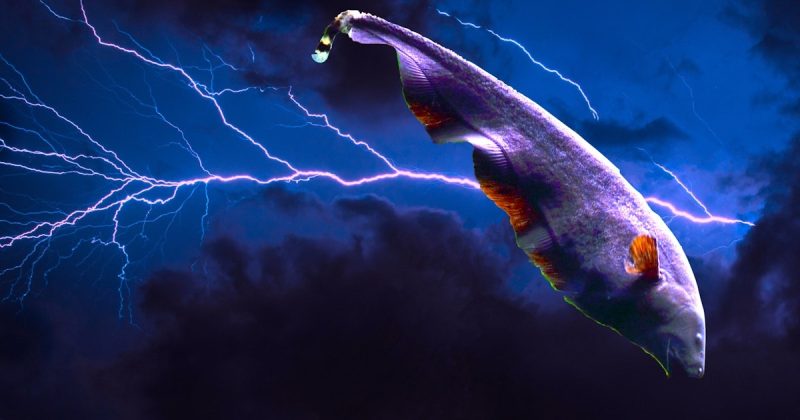Electric fish, known for their astonishing ability to generate and detect electric fields, have long fascinated scientists and mystics alike. In various cultures, these creatures are more than biological marvels—they are seen as messengers, guardians, and embodiments of spiritual power. Their eerie ability to wield invisible energy has earned them a mythic place in the collective imagination, often linked to the unseen forces that govern life, death, and transformation.

What Are Electric Fish?
Understanding Bioelectricity in Nature
In the mysterious depths of rivers, lakes, and murky floodplains, some fish wield a power that borders on the supernatural—electricity. These creatures, known collectively as electric fish, have evolved a remarkable ability: they generate electric fields from within their own bodies. This isn’t science fiction—it’s evolutionary biology at its most electrifying.
Electric fish possess specialized electric organs, typically derived from modified muscle or nerve cells called electrocytes. When these electrocytes fire in unison, they produce an electric discharge that radiates through the water. In some species, these pulses are weak and rhythmic—like an aquatic radar system. In others, they surge with enough voltage to stun prey or drive off would-be predators. Whether used for navigation, communication, or combat, electricity is their secret weapon in a world where sight and sound are often limited.
Among the most famous are the electric eel (Electrophorus electricus), which can deliver jolts of over 600 volts; the electric catfish (Malapterurus spp.), known to silently shock its prey in Africa’s freshwater systems; and the knifefish of South America’s Amazon Basin, which use low-voltage pulses to “see” in pitch-dark waters.
Categories of Electric Fish
Electric fish are generally grouped into two main categories based on the strength and purpose of their discharges:
Strongly Electric Fish
These are the heavyweights of the electric world. Species like the electric eel, electric catfish, and electric rays generate high-voltage discharges powerful enough to immobilize prey, defend against predators, or even explore their environment through electrolocation. In the case of the electric eel, multiple bursts can be fired in quick succession, creating a paralyzing barrage that can knock small fish into submission or startle large animals—including humans.
The electric ray, a denizen of saltwater coasts, uses its pancake-shaped body to deliver powerful shocks when disturbed. These shocks are not just deterrents—they’re hunting tools, allowing the ray to capture fast-moving prey with stunning speed and efficiency.
Weakly Electric Fish
In contrast, weakly electric fish are more subtle and sophisticated. Instead of using electricity as a weapon, they emit low-voltage pulses—often in continuous, rhythmic patterns—that act as a biological sonar. These electric signals help the fish navigate cluttered or murky environments, detect objects, and communicate with one another, even in total darkness.
Species like the black ghost knifefish (Apteronotus albifrons) and the elephantnose fish (Gnathonemus petersii) generate electric fields around their bodies and then detect distortions in those fields caused by nearby objects or other organisms. This process, called electrolocation, is incredibly precise—so much so that these fish can detect the shape, size, and even texture of objects without ever touching them.
In many weakly electric fish, electric pulses are also used for social signaling—to identify individuals, attract mates, or resolve territorial disputes. Each species has its own “electric dialect,” and some individuals even appear to recognize one another based on their unique electric signatures.
Ancient Beliefs and Cultural Symbolism
Spiritual Interpretations Across Civilizations
Long before electric fish were understood through science, they were revered through stories, fears, and spiritual reverence. Across continents and centuries, cultures encountering these mysterious creatures imbued them with meaning far beyond biology. To many, they were not simply animals—but vessels of invisible power, spirit energy, and ancestral presence.
In West African spiritual traditions, particularly among the Yoruba and related groups, electric fish were seen as intermediaries—creatures that could traverse the boundaries between the visible world and the hidden one. Their sudden, shocking power was interpreted as a jolt from the spirit realm, a divine interruption into the mundane. Some oral traditions describe these fish as messengers of the Orishas, divine forces that govern the natural and spiritual world. To touch one was to risk communion—or confrontation—with unseen powers.
In the Amazon Basin, electric eels are both feared and honored. Among various Indigenous groups, these fish are considered sacred inhabitants of the river’s spiritual ecosystem. Legends speak of electric eels as the manifestation of ancestral spirits, protectors of sacred waterways, or enforcers of taboos. Some tribes believe these creatures can influence rain, lightning, or the outcome of hunts—a living link between the sky and the river. Shamans may invoke their image or presence during rituals calling on natural forces, viewing their electric discharges as symbols of raw, unmediated spiritual power.
In parts of Southeast Asia, similar reverence is found among communities living along electric fish-inhabited rivers. Here, they may be seen as guardians of purity, cleansing not just with water but with the unseen energy they carry. In some belief systems, spotting an electric fish during a pilgrimage or offering is considered an omen—either a warning or a blessing, depending on the behavior of the fish and the intention of the observer.
Symbols of Hidden Power and Protection
To mystics, artists, and spiritual seekers, electric fish embody a powerful metaphor: strength that hides beneath stillness. On the surface, these fish may appear calm, even passive. But beneath that serene exterior lies a storm of potential—energy that can burst forth without warning. This duality has made electric fish enduring symbols of hidden power, especially in shamanic and esoteric traditions.
They are often associated with transformation—the idea that true change comes not through visible effort but through inner shifts of energy. Just as the fish releases its charge in a single, decisive moment, so too does personal or spiritual transformation often arrive like a sudden current through the soul.
In protective magic, electric fish take on a talismanic role. Amulets shaped like eels, knifefish, or stylized wave patterns inspired by their discharges are believed to ward off malevolent spirits, much like the fish defends itself in nature. Some African tribes would etch the form of an electric fish into ritual tools, while Amazonian shamans might paint abstract electric motifs onto ceremonial garments or masks used in spirit journeys.
For modern mystics, the electric fish remains a potent totem—a guardian of energy, insight, and self-defense. It reminds us that power doesn’t need to be loud or constant; sometimes, the most powerful force is the one that waits quietly, deep below, until the precise moment to strike.
The Mystical Connection: Why Electric Fish Resonate with the Spirit World
Energy as a Spiritual Medium
Electricity, in many mystical traditions, is more than a physical force—it is the essence of life itself, the invisible current that animates the body, ignites thought, and bridges the soul to the cosmos. While we cannot see electricity directly, we feel its presence: in the crackle of a thunderstorm, the charge of a touch, the hum of the world’s unseen pulse. It is this unseen, untouchable energy that lends electric fish their otherworldly aura.
Much like lightning has been interpreted across cultures as a sign of divine intervention—Zeus’s fury, Thor’s hammer, the sky gods speaking—so too are the electric pulses of fish seen as whispers from the deep. In mystical philosophy, these creatures are thought to operate on vibrational frequencies not unlike those that govern dreams, intuition, and visions. Each pulse they emit is imagined to be a signal across veils—reverberating not just through water, but through the spirit realm, stirring energies that lie dormant in the subconscious.
Shamans, oracles, and spiritual healers often describe electric fish as living conduits, bridging the visible and invisible worlds. Their ability to create energy from within—not from fire or wind or stone, but from their very flesh—is interpreted as a mark of divine favor, or perhaps divine design. They do not borrow power; they are power.
Water and Electricity: A Dual Symbol of Life and Transformation
To understand the mystical symbolism of electric fish, one must consider not only the electricity they wield but also the medium in which they live: water. Water, in nearly every spiritual system, represents the emotional, the intuitive, the unconscious, the sacred feminine. It flows, it nurtures, it reflects. It is both life and mystery.
Electricity, by contrast, is activation—the jolt, the breakthrough, the fire in the veins. It is the spark of creation and the flash of revelation. When electricity courses through water, the result is powerful and unpredictable. It can illuminate or destroy, heal or transform. And this is precisely the liminal space electric fish inhabit: the dynamic frontier between feeling and force, stillness and awakening.
They glide through murky rivers and shadowed lakes, their internal pulses carving awareness into the dark. For many spiritual traditions, this makes them archetypal guides through the unknown—beings who show us that we too carry hidden power, waiting to be summoned. In dreams and visions, electric fish may appear as totems or spirit allies, offering a path forward through confusion, despair, or emotional depth. They remind us that illumination does not always come from above—it often rises from within.
Shamanic Uses and Ritual Practices
Vision Quests and Trance Work
In the heart of ancestral forests, near the banks of sacred rivers where electric fish dwell, shamans and spiritual seekers have long sought guidance not only from what is seen—but from what is felt. In many Indigenous cosmologies, electric fish are believed to carry the pulse of the universe within their bodies, and this rhythmic energy becomes a powerful ally in the realm of altered consciousness.
During vision quests, initiates may symbolically or ritually invoke the spirit of the electric fish to act as a guide through the veils between worlds. As the seeker enters trance—whether through breathwork, chanting, or sacred plant medicines—the imagined electric pulses of the fish are perceived as a spiritual heartbeat, a current pulling the soul deeper into the dreamscape. This energetic rhythm is often compared to the beat of a shamanic drum, both serving to ground and guide the traveler as they cross into non-ordinary reality.
In these altered states, the electric fish becomes more than an animal—it becomes a living compass, showing the path not through sight, but through feeling. The seeker is asked to move like the fish itself: silent, fluid, and attuned to invisible signals. In this symbolic journey, trusting the “electric path” means surrendering logic, allowing intuition to take the lead, and opening to the messages of spirits, ancestors, or one’s higher self.
Healing and Cleansing
Electric fish are not only spiritual guides—they are also seen as agents of energetic purification. In certain traditional healing systems, especially in regions of Africa and the Amazon, symbolic representations of electric fish—drawings, carvings, or even ritual dances—are used to stimulate the flow of energy within a patient or ritual participant.
Healers believe that just as the fish uses its internal charge to navigate and protect itself, so too can its symbolic energy be channeled to dislodge stagnant forces within the human body or aura. Emotional blockages, spiritual toxins, or long-held traumas are viewed as static—clinging to the soul and disrupting the natural flow of life-force. The electric fish, when invoked, is imagined to “shock” these blockages into motion, much like lightning splitting the sky or a defibrillator restarting a heart.
Some rituals may involve water blessed in the name of the electric fish, used to wash the feet, head, or hands of the seeker. Others may involve rhythmic movements mimicking the fish’s undulating swim, designed to reawaken dormant energy within the spine or chest. In all these practices, the electric fish embodies renewal, circulation, and vitality.
To the shaman, it is not merely a symbol—but a living archetype: a creature that teaches through silence, heals through vibration, and reminds us that true transformation comes not from force, but from tapping into the unseen currents of life itself.
Scientific Awe Meets Spiritual Wonder
The Biology Behind the Power
Modern biology has pulled back the curtain on many natural marvels, and electric fish are no exception. Scientists now understand the elegant cellular architecture that enables these creatures to wield electricity: electrocytes, derived from muscle cells, are arranged in intricate stacks like biological batteries. When triggered, they discharge in perfect sequence, creating a voltage capable of navigating, communicating, or even stunning prey. It is a feat of evolutionary engineering—precise, replicable, and measurable.
And yet, even with all this knowledge, the wonder remains.
To witness an animal generate electricity—not with wires or tools, but with its own body—is to encounter something that feels almost alchemical. It is as though life, through countless iterations of natural selection, discovered how to harness the very pulse of the universe and channel it into survival. This capacity to generate and shape energy out of “thin water” is not merely biological; it’s poetic. The more we learn, the more we’re struck by the graceful intelligence encoded in nature, one that mirrors the ancient awe once reserved only for gods and spirits.
In electric fish, the scientific and the sacred are not separate—they dance together, current and flow, logic and mystery.
The Overlap of Science and Symbolism
Perhaps what makes electric fish so captivating is this: they exist at the intersection of two worlds. One is the world of science, where electricity is voltage, electrocytes are tissue, and behavior can be charted in pulses per second. The other is the realm of spirit and story, where electricity is insight, where pulses echo the rhythms of thought and dream, and where the fish itself becomes an archetype—a living symbol of inner power, intuition, and invisible connectivity.
For many spiritual traditions, the fact that such animals exist at all affirms a deeper truth—that energy is not just physical, but also metaphysical. It is the thread that binds body to soul, soul to cosmos. In this light, electric fish are not just evolutionary oddities; they are living metaphors, reminders that life operates on many frequencies, some of which we cannot see, yet still feel.
They teach us that vital force can be quiet, hidden beneath calm waters, until the moment it surges forth. That power can be internal, subtle, and yet no less real. That being attuned to unseen forces—whether they be electrical, emotional, or spiritual—is a survival strategy shared by fish, mystics, and perhaps all of us.
Modern Echoes of Ancient Wisdom
Electric Fish in Dreams and Metaphysical Thought
Though ancient myths and indigenous rituals once held the electric fish as sacred, its symbolic resonance has not faded in the modern age. Instead, it has found new meaning in the realm of dream interpretation and metaphysical psychology. In today’s spiritual literature, when electric fish appear in dreams, they are often seen as harbingers of inner awakening—signals that something powerful and transformative is stirring just beneath the surface of consciousness.
These creatures, emerging silently from the depths of sleep, may symbolize the invisible currents shaping our waking lives: an intuition we’ve neglected, an emotional energy we haven’t yet named, or a potential within us waiting to be released. Just as electric fish generate force from within, their appearance in a dream is a nudge to look inward—to trust one’s own energetic intelligence, even when logic falls silent.
Dream analysts and spiritual guides often interpret the electric fish as a totem of dormant gifts—capabilities or sensitivities buried beneath the noise of daily life. The dream is not a warning, but a gentle charge, awakening the dreamer to their own capacity for influence, connection, and self-illumination. It asks: What power lies beneath your stillness? And when will you choose to release it?
Contemporary Spirituality and Energy Awareness
In a world increasingly fascinated by energy healing, chakras, and vibrational medicine, the electric fish emerges not just as a biological marvel, but as a symbolic teacher. Its very body resonates with ideas central to modern spirituality: that all matter is energy, that flow is more important than force, and that tuning in—rather than powering through—is the key to healing and growth.
Practitioners of reiki, sound therapy, and subtle energy work often speak of aligning internal currents, unblocking flow, or attuning to frequencies. The electric fish does all this instinctively. It feels the world through vibration, communicates in invisible pulses, and navigates by sensing distortions in its own energy field. In this way, it mirrors human practices of aura awareness, biofield sensing, and energetic empathy.
For many in contemporary spiritual circles, the electric fish becomes an ambassador of energetic consciousness. It offers a living metaphor for beings who are tuned to the unseen, whose strength comes not from size or voice but from their connection to subtle, internal power. It affirms that sensitivity is not weakness—it is wisdom in another language.
More than ever, in an age where people seek reconnection with the deeper currents of life, the electric fish reminds us that the most profound forces are often felt, not seen. And in embracing this, we return—full circle—to an ancient truth long known by shamans and seers: that life itself is energy, flowing through all things, waiting to be known, trusted, and released.
Conclusion: Nature’s Electric Emissary
Electric fish are a stunning convergence of science and spirit. They reveal the astonishing capabilities of life to harness invisible forces, but they also speak to something older and deeper—a spiritual truth embedded in the natural world. Across cultures and continents, these beings are seen not just as biological wonders but as symbols of transformation, protectors of hidden power, and emissaries of energy from realms beyond the visible.
Whether viewed through the lens of biology or mysticism, electric fish remain profoundly compelling. They remind us that power does not always roar. Sometimes, it pulses silently in the dark, waiting to be understood.






